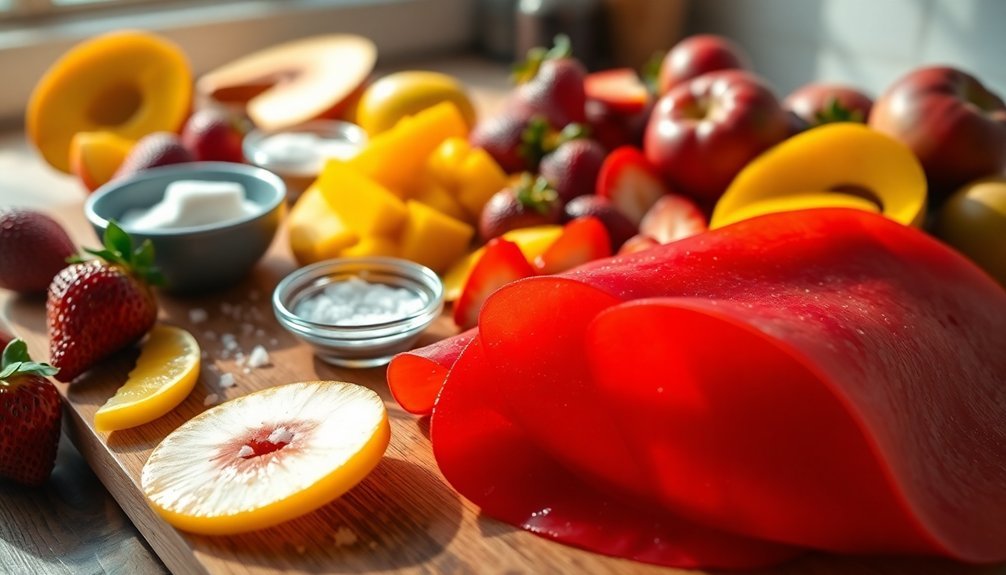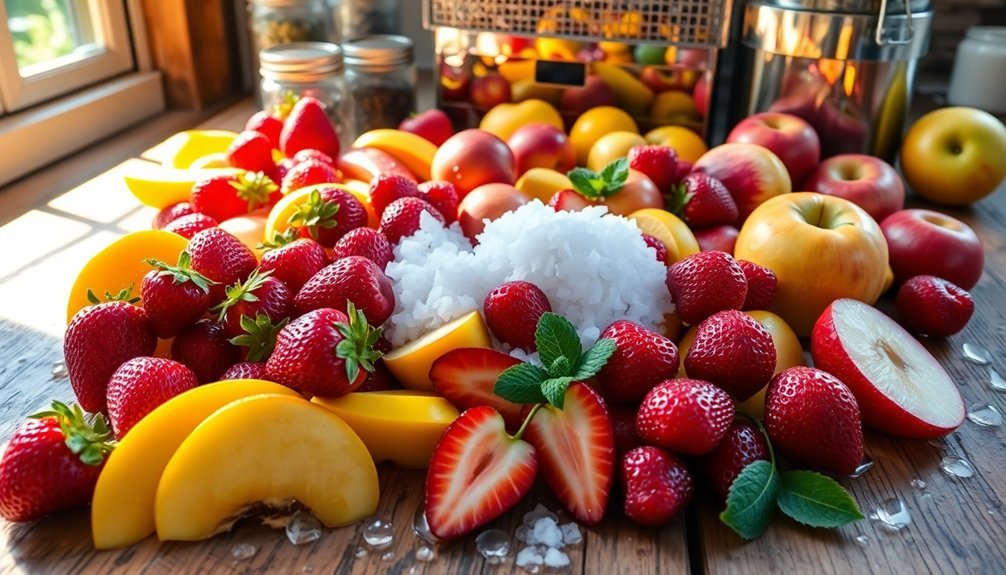Making fruit leather at home typically costs you between $1 to $2 per cup of ingredients. The price varies depending on the type of fruit you use; fresh fruit is usually pricier than canned or frozen options. If you opt for store-bought fruit leather, expect to pay around 50 cents per piece. Factors such as fruit quality, seasonal availability, and operational expenses can increase costs. Utilizing overripe or surplus fruits can help reduce waste and lower expenses. There's plenty more to evaluate when making your own, so explore the various aspects for a better understanding.
Raw Material Costs

When making fruit leather, the costs of raw materials can vary considerably based on the type of fruit you choose and how you source it. Fresh fruits tend to be pricier than canned or frozen options, so keep that in mind when budgeting. Seasonal availability can also impact prices; using surplus or slightly overripe fruits can help you save money while reducing waste. You'll need about 6 cups of fruit for a basic recipe, so consider the quantity when selecting your ingredients. If you're adding natural sweeteners like stevia or erythritol, remember that these will increase your overall costs. Lemon juice is optional, but it can also contribute to your budget. When selecting fruits, aim for those that are ripe or slightly overripe to guarantee ideal flavor and texture. Tough-skinned fruits will need peeling, while soft-skinned fruits can be used as is. Always prioritize fruit purity and quality to avoid any contaminants in your final product. Additionally, mixing fresh, canned, and frozen fruits can enhance both your resource efficiency and flavor profile. Interestingly, approximately 30% of fruits produced are wasted, presenting an opportunity to utilize surplus fruits effectively in your fruit leather production.
Equipment and Infrastructure Costs
Investing in the right equipment and infrastructure is fundamental for producing high-quality fruit leather. A commercial fruit leather production line can cost between $16,500 for smaller setups (5-19 pieces) to $35,000 for larger operations (1-4 pieces). Key machines include the fruit leather shaping machine, blender, and steam cooker, all essential for your process.
You'll need an effective control system, like Siemens PLC, to guarantee automation and efficiency.
Infrastructure costs can add up, too. In India, building and civil construction might set you back ₹5.18 lakhs, while utilities like power and water facilities could cost an additional ₹0.8 lakhs.
Don't forget about storage; maintaining raw materials at controlled temperatures is critical for quality.
Additionally, plan for contingency funds (around ₹1.20 lakhs) and pre-operative expenses (approximately ₹0.90 lakhs) to cover unexpected costs. Regular maintenance is necessary to keep everything running smoothly, and investing in durable materials will minimize long-term upkeep.
Labor Costs

Labor costs play an essential role in the overall expense of fruit leather production, as they encompass both skilled and unskilled workers at various stages of the process. You'll need personnel for fruit selection, washing, peeling, and pureeing, as well as for spreading the puree on drying trays and monitoring the dehydration. Seasonal labor might be necessary to handle fluctuating fruit supplies, adding another layer to your cost structure. It's important to consider that fruit leather is a nutritious snack option, which can influence consumer demand and, consequently, labor needs throughout the production cycle.
Here's a breakdown of labor requirements you might encounter:
| Task | Skill Level | Estimated Time |
|---|---|---|
| Fruit preparation | Unskilled | 20 minutes/batch |
| Monitoring dehydration | Unskilled | 6-10 hours |
| Quality control | Skilled | Varies |
| Packaging | Unskilled | Varies |
| Training new employees | Skilled | Ongoing |
These labor requirements contribute considerably to your production costs. Remember, labor expenses can vary by region due to wage standards and regulations, so it's vital to factor in these variations when planning your budget.
Operating Costs
Operating costs can greatly impact your fruit leather business, encompassing various vital expenses that directly affect profitability.
First, consider raw materials costs. You'll need to factor in the price of fruits, whether fresh, canned, or frozen, and any sweeteners or additives. Packaging materials also add to your expenses, so choose wisely.
Next, think about utility costs. Operating dehydrators or ovens for drying can lead to significant energy consumption, and don't forget about water usage for washing the fruits. If you're using machinery like steam cookers, you'll incur additional energy costs as well.
Transportation and distribution costs are another important factor. You'll spend on transporting raw materials to your production site and distributing the finished products. Logistics, including storage and handling, also need to be accounted for.
Lastly, miscellaneous operating costs like maintenance, quality control, and marketing can quickly add up. You'll also need to guarantee compliance with food safety regulations and manage waste effectively.
Keeping a close eye on these operating costs can help you maintain profitability while running a successful fruit leather business.
Capital Investment

When you're ready to invest in fruit leather production, you'll need to take into account the costs of equipment and facility setup.
Purchasing specialized machinery like shaping machines can greatly affect your budget, along with the expenses for constructing a suitable production space.
Evaluating these capital investments is essential for ensuring a successful launch of your business.
Equipment Purchase Expenses
Investing in the right equipment is essential for establishing a successful fruit leather production business. The cost of machinery can considerably impact your startup expenses, so it's vital to understand what you need. Here's a quick look at some essential machines and their functions:
| Equipment Type | Manufacturer |
|---|---|
| Fruit Leather Processing Line | SHJUMP |
| Full Automatic Fruit Roll up Machine | Genyang |
| Commercial Production Line | Keyfood |
| Industrial Cutting Machines | Urschel Laboratories |
Each machine comes with its own specifications, like power consumption and processing capacity. For instance, the Fruit Leather Processing Line has a processing capacity of 2-3 tons per day, while the Full Automatic Fruit Roll up Making Machine can handle between 200kg to 10T per hour.
When choosing your equipment, consider not only the initial purchase price but also the durability and maintenance costs, as machines made from stainless steel offer longevity and ease of cleaning. This upfront investment in quality equipment will set the foundation for your fruit leather production success.
Facility Setup Costs
Setting up a facility for fruit leather production requires careful consideration of various capital investment costs.
You'll need to evaluate whether leasing or purchasing a space best fits your long-term goals. Leasing a 10,000-square-foot facility can range from $20,000 to $40,000 per month, while buying one may cost between $2 million to $5 million, not including renovations and equipment.
Your facility must also meet essential production and safety standards, which means factoring in costs for renovations and upgrades.
Additionally, ongoing expenses like utilities, maintenance, and insurance can add another 10% to 20% to your overall budget.
Here are some key considerations for facility setup costs:
- Lease or purchase costs: Decide based on financial flexibility and growth plans.
- Land acquisition: Pricing varies considerably by location.
- Construction expenses: Factor in local regulations and environmental compliance.
- Renovation needs: Confirm the facility meets production capabilities and safety standards.
- Ongoing expenses: Budget for utilities, maintenance, and insurance to sustain operations.
Cost Comparison: Homemade vs. Store-Bought
Comparing the costs of homemade and store-bought fruit leather reveals substantial differences that can impact your budget.
When you make fruit leather at home, your main expenses come from ingredients like fruit and optional applesauce, which only run about $1 to $2 per cup. The total costs spread over multiple servings, resulting in a cost of just pennies per serving.
Plus, you'll have the added benefit of controlling ingredients and avoiding added sugars or preservatives.
In contrast, store-bought fruit leather typically costs around 50 cents per piece or more, especially for organic varieties.
These prices don't decrease considerably when buying in bulk, leading to higher long-term costs.
While store-bought options are convenient, they often contain unhealthy additives and flavors that limit your choices.
Factors Affecting Production Costs

Producing fruit leather involves several key factors that can greatly impact overall costs. First, raw material costs play an important role. The type and quality of fruit you choose, along with its seasonal availability, can either increase or decrease your expenses. For instance, using Jardalu mangoes may require specific quantities depending on your processing capacity.
Additionally, equipment and machinery costs can't be overlooked. Setting up a production line involves an initial investment, with prices ranging from $16,500 to $35,000. Maintenance and energy consumption also add to ongoing expenses.
Labor and manpower costs are another essential factor. Hiring skilled workers, training them, and managing operational hours can considerably affect your budget.
Lastly, operational and overhead costs, such as location, utilities, packaging, and marketing, further influence your total expenditure.
Here are some factors affecting production costs:
- Fruit quality and quantity
- Initial investment for machinery
- Skilled labor requirements
- Seasonal availability of raw materials
- Packaging and marketing expenses
Tips for Reducing Costs
Often, you can considerably cut costs when making fruit leather by being strategic about your choices. Start by using affordable fruit sources. Canned or frozen fruit, processed at peak ripeness, can be cheaper than fresh options. You can also use slightly over-ripe fruit or leftovers from other recipes to minimize waste and expenses. Buying in bulk or during sales can further reduce costs.
When it comes to additional ingredients, stick to natural sweeteners like honey or corn syrup in minimal amounts. Use lemon juice or ascorbic acid instead of commercial preservatives, and keep your puree simple. Applesauce can help extend the leather while smoothing out tartness, saving you more.
Efficient preparation methods can also save you money. Using a dehydrator is an effective way to dry your fruit, but sun or oven drying can work, too. Make large batches to maximize equipment use and reduce the cost per unit. Reuse non-stick silicone baking mats to cut down on expenses.
Lastly, store your fruit leathers properly to extend shelf life. This cuts down on frequent production while allowing you to enjoy your homemade snacks without waste.
Frequently Asked Questions
How Long Does It Take to Make Fruit Leather?
Making fruit leather takes about 6-24 hours, depending on your drying method. Active prep takes 20-40 minutes, while the drying process can range from several hours to a couple of days. Planning ahead's key!
What Fruits Work Best for Making Fruit Leather?
When making fruit leather, berries, stone fruits, tropical fruits, and even some vegetables work best. Combine them for unique flavors, and don't forget to use fruits high in pectin for the best texture!
Can I Freeze Homemade Fruit Leather for Later Use?
Yes, you can freeze homemade fruit leather for later use. Roll it in parchment paper, place it in a freezer bag, and store it in the freezer. It'll maintain quality for up to a year.
Are There Any Allergens in Typical Fruit Leather Recipes?
Typical fruit leather recipes don't inherently contain allergens, but cross-contamination can occur. Always check processing facilities to guarantee the fruit and other ingredients remain allergen-free to keep your homemade treat safe.
How Should I Store Homemade Fruit Leather?
To store homemade fruit leather, keep it in a cool, dry place in airtight containers or zip-top bags. For longer shelf life, refrigerate or freeze it, ensuring you handle it with clean, dry hands.
In Summary
In conclusion, making fruit leather can be a rewarding and cost-effective endeavor when you understand the various expenses involved. By considering raw materials, equipment, and labor, you can better gauge your overall investment. While homemade options might save you money compared to store-bought versions, keep in mind the factors that can influence production costs. With a few smart strategies, you can enjoy delicious, homemade fruit leather without breaking the bank!





Leave a Reply